
Breath is life, and nowhere is this more evident than in the practice of yoga. While many associate yoga with contorted poses and physical flexibility, the foundation of this ancient discipline lies in the art of breathing. In yoga, breathing techniques, or pranayama, are a fundamental component that can profoundly influence one's physical, mental, and spiritual well-being.
Pranayama: The Essence of Breath Control
Pranayama, derived from the Sanskrit words "prana" (life force) and "yama" (control), is the practice of breath control. It involves deliberate regulation of the breath, which has a direct and profound impact on the body and mind. In yoga, the breath is considered the bridge between the physical and mental aspects of the self.
The Importance of Pranayama
1. **Stress Reduction:** One of the most immediate benefits of pranayama is its ability to reduce stress and anxiety. By practicing controlled, deep breaths, the parasympathetic nervous system is activated, promoting relaxation and calm.
2. **Enhanced Concentration:** Conscious control of breath enhances focus and concentration. Yogic breathing techniques encourage mindfulness, allowing practitioners to be fully present in the moment.
3. **Improved Lung Capacity:** Deep, controlled breathing helps to expand lung capacity, improving oxygen intake and overall respiratory health. This can be especially beneficial for individuals with respiratory conditions.
4. **Energy Regulation:** Pranayama can help balance and channel the body's energy, promoting vitality and reducing fatigue. Various breathing techniques can either invigorate or calm the practitioner, depending on their specific needs.
Types of Pranayama
There are numerous pranayama techniques in yoga, each serving a specific purpose. Here are a few of the most commonly practiced ones:
1. **Diaphragmatic Breathing (Abdominal Breathing):** This fundamental technique involves deep, slow breaths that engage the diaphragm, helping to expand the lungs fully.
2. **Ujjayi Breathing:** Also known as "ocean breath," ujjayi involves constricting the back of the throat during inhalation and exhalation, creating a gentle, soothing sound. It is often used in asana practice to enhance focus and regulate body temperature.
3. **Nadi Shodhana (Alternate Nostril Breathing):** This pranayama involves inhaling and exhaling through alternate nostrils. It is believed to balance energy channels and calm the mind.
4. **Kapalabhati (Skull Shining Breath):** Kapalabhati is a vigorous breath exercise where forceful exhalations are followed by passive inhalations. It helps clear the mind and invigorate the body.
5. **Bhramari (Bee Breath):** In Bhramari, the practitioner inhales deeply and then exhales while making a humming sound similar to that of a bee. It has a calming effect and can alleviate stress and anxiety.
Incorporating Pranayama into Your Practice
If you're new to pranayama, it's essential to start slowly and seek guidance from a qualified yoga instructor. Integrating breath control into your yoga practice can be both rejuvenating and transformative. Here are some tips for incorporating pranayama:
1. **Find a Quiet Space:** Pranayama requires concentration and focus, so choose a quiet, calm space for your practice.
2. **Start with Basic Techniques:** Begin with simpler techniques like diaphragmatic breathing and gradually progress to more advanced forms of pranayama.
3. **Regular Practice:** Consistency is key. Incorporate pranayama into your daily routine, either as a standalone practice or in conjunction with your yoga asanas.
4. **Stay Mindful:** Pay attention to your body's response and adjust your practice accordingly. Listen to your body and never force the breath.
In conclusion, pranayama is an integral component of yoga that has the potential to transform your physical, mental, and spiritual well-being. By harnessing the power of breath, you can reduce stress, enhance concentration, and promote overall health. Whether you're a seasoned yogi or a newcomer to the practice, exploring the world of pranayama can be a deeply rewarding journey toward self-discovery and well-being.
NEXT ARTICLE

Earlier this year in March, Prime Minister Narendra Modi formally declared "Yoga for One Earth, One Health" as the theme for International Yoga Day 20...